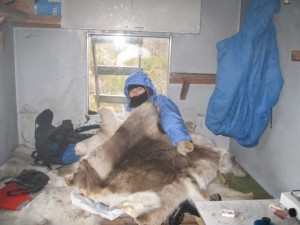C-Jae Morden
MSc. Student
Contact Information
Department of Biology
Concordia University (Loyola Campus)
7141 Sherbrooke St. W. H4B 1R6
Montreal, QC, Canada
Office: SP301.16
Lab: SP434
(514) 848-2424 (ext. 4021)
Education
2008 – 2010: Biology Graduate Student at Concordia University
2002 – 2006 Honours BSc. Biology at University of Winnipeg
My Project
Feasibility of faecal hormones as a non-invasive population monitoring and management method for woodland caribou
Background
Information on demographic parameters is useful to assist in monitoring population condition and trend. Indeed, the effective management of animal populations requires knowledge of population sizes and structures. It is however generally difficult to get this information, especially for elusive and rare species, that exist at low density over vast areas, such as the woodland caribou, a species that is threatened or endangered throughout Quebec and elsewhere in Canada. Accordingly, material from noninvasive specimen is increasingly being used especially for population size estimates and results are promising. We must however also be able to estimate other key population parameters such as the age and sex structure, hence the need to investigate on the possibilities that offer the use of faecal hormones.
Field Work
We will be studying a reindeer population from the Kutuharju Field Reindeer Research Station in Kaamanen, Finland (69°N, 27°E). This herd is composed of semi-domestic reindeer that are free ranging for most of the year excluding the calving and rutting periods. These animals are managed and harvested by the Finnish Reindeer Herders Association, therefore, we are able to continuously gather information on the ecology and behaviour of the individual reindeer. See pictures
Laboratory Analysis
Faecal and blood samples from the first field season will be shipped to the Central Laboratory of the Norweigian School of Veterinary Science in Oslo, Norway where hormone extraction procedures and analysis will commence. Once these techniques are learned, we will finish the first and second year samples back at Concordia University.
Objectives
• Validate the use of hormones from faeces, by assessing the relationship between hormone levels from faeces and plasma.
• Assess the feasibility and accuracy of using faecal hormones to generate some key population parameters such as the age and the sex structures, but also the reproductive status of the individuals. To do this, we will extract progesterone, oestrogen and testosterone from the faeces and assess the pattern of variation in relation to sex, age and reproductive status.
• Pellets size will also be measured (diameter) so that we could assess its relationship with age classes as well as hormone concentration levels.
• Assess seasonal variation of different hormone concentrations from pre-rut to calving.
Publications
C.C. Morden, R.B. Weladji, E. Rosptad, E. Dahl & Ø. Holand (2011) Use of faecal pellet size to differentiate age classes in female Svalbard reindeer Rangifer tarandus platyrhynchus. Wildlife Biology 17:441-444
C.C. Morden, R.B. Weladji, E. Ropstad, E. Dahl, Ø. Holand, G. Mastromonaco & M. Nieminen (2011) Faecal hormones as a non-invasive population monitoring method for reindeer and caribou. Journal of Wildlife Management 75: 1426-1435.
C. Morden, R.B. Weladji, Ropstad, E., Holand, Ø. (2009). Use of faecal pellet size to differentiate between age classes in reindeer/caribou (Rangifer tarandus). 34e congrès annuel pour le Société Québecoise pour l’Etude Biologique du Comportement, 13-15 Novembre, 2009, Trois-Rivières, Québec, Canada (Abstract, page 53; poster)
C. Morden, R.B. Weladji, , Ropstad, E., Holand, Ø. (2009). Faecal hormones as a non-invasive population monitoring and management method for woodland caribou. 7th International Conference on Behaviour, Physiology and Genetics of Wildlife, 21-24 September 2009, Berlin, Germany (Abstract, page 130; presentation)